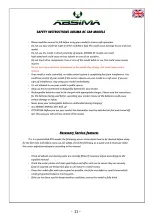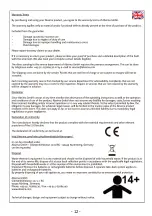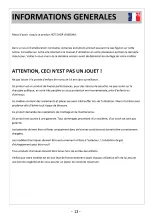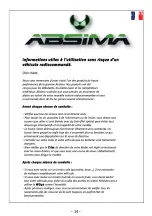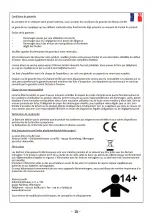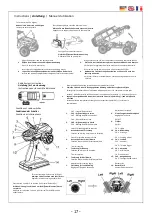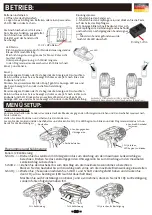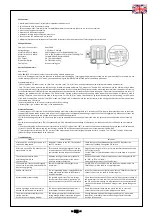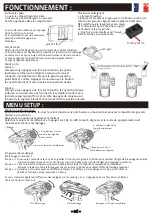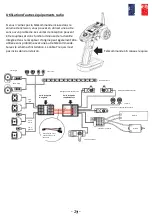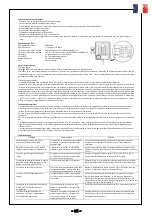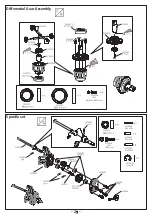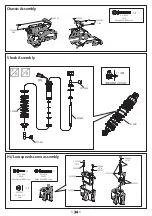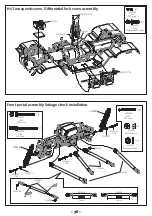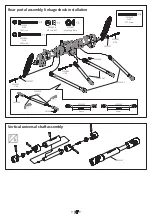
ESC Features
:
• Water-proof and dust-proof, suitable for all-weather condition races.
• Small size with built-in capacitor module.
• Three running modes: Forward /Brake, Forward/Brake/Reverse and Forward /Reverse, fits for various vehicles.
• Great current endurance capability.
• Great built-in BEC output capacity.
• Automatic throttle range calibration, easy to use.
• Easy to set the ESC parameters with jumpers.
• Multiple protections: Low voltage cut-off protection for battery / Over-heat protection / Throttle signal loss protection.
ESC Specification:
Fwd. Cont. /Peak Current:
60A/360A
Voltage Range:
2-3S LiPo or 5-9 NiMH
Motor Limit 2S or 6 NiMH:
540/550 Motor ≥12T or RPM<30000 @7.2V
Motor Limit 3S or 9 NiMH:
540 or 550 Size Motor: ≥18T or RPM< 20000 @7.2V
Resistance:
Forward 0.001Ω, Reverse 0.002Ω
BEC Output:
3A / 6V (Switch Mode)
Dimension/Weight:
36.5x32x18 mm / 39g
Cooling Fan:
Without cooling fan
Set the ESC parameters:
How to set:
1060-BRUSHED ESC uses the jumper cap to set running mode & battery type.
Way to set: We suggest users use the tweezers to set parameters by plugging / unplugging the jumper cap (as shown in the picture beside); For example, if want
set the battery type to the “LiPo” mode, you only need to plug the jumper cap into left two pins of the battery pin header.
Programmable items:
1. Running Mode: 3 Options (Fwd / Br / Rev, Fwd / Br, Fwd / Rev). “Fwd / Br / Rev” is the default option (Fwd=Forward, Br=Brake, Rev=Reverse)
“Fwd / Br / Rev” mode indicates the vehicle can go forward, backward and brake. This mode uses “Double-click” method to make the vehicle reverse. When
moving the throttle stick from the neutral zone to backward zone for the 1st time, the ESC begins to brake the motor and the motor slows down but still running,
so the backward action is NOT performed immediately. When the throttle stick is moved to the backward zone again, if the motor speed slows down to zero (i.e.
stopped), the backward action will happen. This “Double-click” method prevents mistakenly reversing action when the brake function is frequently used in
steering. Therefore, this mode is often used in daily practice. For the “Fwd / Br” mode, the vehicle can go forward and brake, but no reversing, so this mode is
often used in competition. And the “Fwd / Rev” mode uses “Single-click” method to make the vehicle reverse, when moving the throttle stick from neutral zone
to backward zone, the vehicle
reverses immediately, so this mode is usually used for rock crawling.
2. Battery Type: Lipo or NiMH, the “Lipo” is the default option.
Protection Features:
1. Low Voltage Cutoff Protection: If the voltage of battery pack is lower than the threshold for 2 seconds, the ESC will enter the protection mode, so the motor
speed will be lowered (when voltage is lower than the 1st trigger point) till stopped (when voltage is lower than the 2nd trigger point). When the car stops, the
red LED blinks to indicate the low voltage cut-off protection has been activated.
2S LiPo: When voltage is below 6.5V, the output power will be halved. When the voltage is lower than 6.0V, the output will be cut off and won’t be resumed
again.
3S LiPo: When voltage is below 9.75V, the output power will be halved. When the voltage is lower than 9.0V, the output will be cut off and won’t be resumed
again.
2. Over-heat Protection: When the internal temperature of the ESC is higher than 100°C, this protection will be activated and the output power will be reduced
till cut off. The RED LED blinks when the vehicle stops, and the ESC will not resume output power until its temperature is below 80°C.
3. Throttle signal loss protection: The ESC will cut off the output power if the throttle signal has been lost for 0.1 second. The “Fail Save” function of the radio
system is strongly recommended to be activated.
Trouble Shooting:
Troubles
Possible Causes
Solutions
After power on, no LED lights up, no self-
test and no beep sound.
No power is drawn to the ESC; The switch of
the ESC is broken.
Check the connections between battery and ESC. Re-solder the
connectors if needed; Change the ESC switch.
After turn on, the RED LED blinks but the
motor doesn’ t work.
Throttle wire is wrongly plugged or into the
incorrect channel; The ESC can’t successfully
complete the throttle range self-calibration.
Plug the throttle signal wire correctly into the throttle channel (usually
Ch2) of the receiver;
Set the “TRIM” of throttle channel to 0 or turn the knob to its neutral
position.
The car runs backwards when
accelerating forward on
the transmitter.
Direction setting of the throttle channel is
incorrect in the transmitter or the motor
wires are wrongly connected.
Reverse the direction of the throttle channel, from the original “NOR”
to “REV” or “REV” to “NOR”;
Swap the wires between the ESC and motor.
The vehicle can’t reach to the full speed
even at the full throttle, and the RED LED
doesn’ t keep lighting.
There are some incorrect settings in the
transmitter.
Set D/R, EPA, ATL to 100% or turn the knobs to maximum value. Set
TRIM to 0 or turn the knob to its neutral position.
Vehicle can’t reverse.
The corresponding jumper is plugged into the
wrong position; Neutral point of throttle is
drifted or deviated.
Insert the jumper into the right location; Set the “TRIM”of the throttle
channel to 0 or turn the knob to its neutral point.
Motor suddenly stops running.
The throttle signal is lost; The low voltage
cutoff protection or thermal protection (i.e.
over heat protection) of the ESC is activated.
Check connection between ESC and receiver). Check battery voltage of
the transmitter if it is too low; The red LED on the ESC blinks, denoting
the ESC is under low voltage cut-off protection or over-heat protection.
Let the ESC cool down. If the battery voltage is low, please change the
battery.
Vehicle neither go forward no reverse,
but the LED indicators work normally.
The connection between ESC and motor is
interrupted; The motor is damaged.
Check the connectors between the motor and ESC to ensure all
connections are firm and reliable; Replace a new motor.
The motor accelerates rapidly at the
startup moment,
but has lockout or cogging problem.
The discharge capacity of the battery is not
strong enough; Motor rotates too fast; gear
ratio is too aggressive; driveline not ok
Change battery with better discharge capability; Use a motor with
lower RPM, or smaller pinion to soften the gear ratio; Check the
driveline of the vehicle.
- 25 -
Summary of Contents for CR 3.4
Page 1: ...BENDIENUNGSANLEITUNG MANUAL mode d emploi 1 10 SCALE 4WD ELECTRIC CRAWLER ...
Page 2: ... 1 ...
Page 3: ... 2 ...
Page 4: ... 3 ...
Page 5: ... 4 ...
Page 6: ... 5 ...
Page 7: ... 6 ...
Page 8: ... 7 ...
Page 9: ... 8 ...
Page 10: ... 9 ...
Page 11: ... 10 ...
Page 12: ... 11 ...
Page 13: ... 12 ...
Page 14: ... 13 ...
Page 15: ... 14 ...
Page 16: ... 15 ...
Page 17: ... 16 ...
Page 50: ...Absima GmbH Gibitzenhofstr 127a RG 90443 Nürnberg Germany Web www absima com ...

